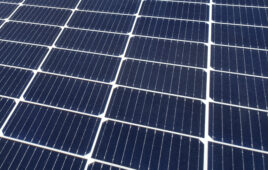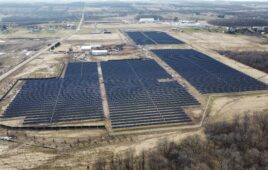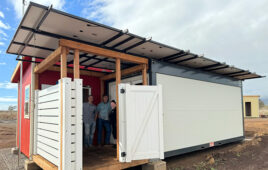Last Friday, March 16 was the deadline for requests for exemption for products and companies looking to bypass the current 30% tariffs on imported solar cells and panels. Public comments on the exemption requests will be accepted through April 16, and any final decisions will be made by U.S. Trade Representative Robert Lighthizer, after consultation with Secretary of Commerce Wilbur Ross and Secretary of Energy Rick Perry.
Solar Power World combed through 52 submissions, some more serious than others. Each request must describe how the product up for exemption is different than conventional crystalline silicon PV (CSPV) products under the tariff. What follows is a list of requests of significance to the U.S. residential, commercial and utility solar markets. When not obvious, we provide the explanation on how the product differs from conventional CSPV products:
SunPower provided the most documentation to support exemption of its copper-plated interdigitated back contact (IBC) solar cells used in high efficiency modules. More generally, distributor BayWa r.e. Solar Systems jointly filed with LG Electronics USA to request exclusion of all IBC solar modules.
Enphase requests an exemption for “all microinverters, whether or not incorporated into AC modules.” Enphase is not requesting AC modules to be excluded entirely, just the microinverter portion. The solar panel can still be tariffed, but the microinverter shouldn’t be, says Enphase. LG Electronics USA, on the other hand, is specifically asking for exemption of its AC modules.
SolarEdge seeks exemption for its smart modules. Similar to Enphase’s AC module scenario, SolarEdge says, if anything, the attached power optimizer should be excluded from the tariff if the whole module is tariffed.
Panasonic wants a “specific type of high-efficiency cells featuring advanced technology performance characteristics” that are “clearly differentiated from the conventional lower-efficiency, low-priced imports” to be excluded. The exclusion is necessary, says Panasonic, to enable ramp-up of module production at the Tesla plant in Buffalo and will support $5 billion in investments and create 1,500 manufacturing jobs. Panasonic says there is no domestic substitute for the Panasonic/Tesla product.
JinkoSolar requests exemption for its p-type monocrystalline PERC cells because they will “be incorporated in solar panels produced in the United States… in a newly constructed domestic solar panel manufacturing facility.”
Solaria wants to exclude its high-performance, high-efficiency PowerXT line of modules. The 340-W and 410-W modules are almost entirely sold in the United States, although they are mostly manufactured in South Korea (with a few coming out of a 40-MW manufacturing plant in California). The Solaria PowerXT module costs approximately twice as much as a conventional module, and Solaria says its high-end value and unique design distinguishes it from the rest of panels sold in the United States.
Canadian Solar wants high-density modules (HDM) exempted as they make up a small portion of the U.S. market. HDM technology allows for more cells in a module and therefore generates greater power. Canadian Solar also referenced Seraphim Solar of China and Solaria as fellow producers of HDM modules.
U.S.-based Sunpreme wants its unique bifacial, double-glass modules excluded because they’re produced in China. Sunpreme manufactures a bifacial solar cell using thin-film technology over a crystalline silicon wafer.
U.S. installer Sunrun filed with REC to exclude REC’s 120-half-cut-cell modules with three junction boxes. REC’s TwinPeak modules can effectively work as two separate modules, REC says, since its half-cut cells are positioned on separate ends of the panel.
Hanwha Q CELLS wants its 144-half-cut-cell, six-busbar modules excluded, since they are primarily used in utility-scale applications and not currently produced by any U.S. companies. Hanwha also wants all 72-cell, steel framed modules to be excluded, for the same reasons.
Wafer manufacturer 1366 Technologies wants its direct-to-wafer technology excluded. The U.S. developed and patented technology is currently under construction in Southeast Asia in Hanwha Q CELLS modules.
Kyocera thinks its Japan-manufactured KK280P-3CD3CG solar panels should be excluded as they are installed in projects for “industrial manufacturing or warehouse facilities” and have not yet sold into the United States. The conventional 280-W, 17% efficient panel has patented drainage channels in the frame to facilitate waterflow from the glass surface.
EU ProSun, a group that represents 80% of European solar cell and module production, supports the United States taking action against cheap imports but it wants exemption for its European-made panels because their prices are similar to U.S. panels.
RECOM wants exemption for its European-made panels, specifically because the RECOM product “is an innovative solar module combining three technologies in one module: quasi-mono cells with PERC technology and five busbars.” RECOM says its production costs are already high for Europe, and its average selling price of $0.51-$0.61/watt is similar to U.S. manufacturers’.
SolarWorld Industries GmbH of Germany wants its bifacial modules exempted because they are “high-quality” and priced “significantly above the U.S. and international average.”
DSM is looking for exemption of all metal wrap through passivated emitter cells (MWT PERx). The coating and backsheet manufacturer requests the exemption “to enable the growth of the high-efficiency module assembly industry in the USA.” DSM could not find any U.S. imports of MWT PERC cells between 2014 and 2017 but expects companies to adopt the innovative architecture in the near future.
Roofing manufacturer GAF wants its frameless, 60-cell, all-black PV laminates (the DecoTech system) to be excluded. GAF says its product is used in “roof-integrated photovoltaics” with laminates sourced from Canada “only after U.S. producers declined to provide laminates that meet GAF’s requirements.” GAF obtains the laminates and then assembles them into modules.
North Carolina solar developer Pine Gate Renewables requests all 1,500-volt bifacial modules be excluded since there are no equivalent U.S. producers.
A “Utility-Scale Solar Coalition” comprising Cypress Creek Renewables, EDF Renewable Energy, E. ON North America, NRG Renewables, sPower, Southern Current, Swinerton Renewable Energy and Tradewind Energy, requests that all 72-cell, 1,500-volt modules be excluded as they are “required for utility projects but not sufficiently available from domestic sources.”
GCL wants its mammoth 450-W modules (GCL-P6/96) modules exempted as there is obviously no U.S.-manufactured equivalent. It is 80 lb and 8.4 ft long.
Maxim Integrated wants its semiconductor products excluded from tariffs. Maxim manufactures cell-level optimizers that have become more popular as rapid shutdown requirements have gone into effect.
Onyx Solar Group wants its solar-cell-embedded glass excluded, as it is used in BIPV products.
SmartFlower North America wants its 12-panel “sunflower” arrays to be excluded from the tariffs. The SmartFlower “Unique Panels” have no metal frame, use a dual-glass laminate and ship as the full design.
And maybe most interestingly….
Google wants specific dual-glass, frameless solar shingles excluded because Google wants to use them on two buildings it is currently constructing. The solar shingles produce about 85 W each and will be manufactured by Sunstyle AG, a Swiss company, and Saint-Gobain S.A., a French company.





While I am opposed, the tariff should apply to All or none. I don’t think we have enough special classes in America that are catered to that are messing everything up for everybody else? Enough is enough. Let’s just talk competing ain a fair transparent market place to place to everyone and see where that goes.
Utility-scale and 1500 volt exemptions for the sake of being utility-scale are bogus. The only thing that will save solar Jobs in a declining market is a refocus on rooftop value. Such an import tariff should have been negotiated with a federal net metering law. If all of these exemptions are granted it will continue to divide the solar industry between big solar and small solar.
Either we should have an absolutist import tariff such that everyone can realize what a terrible idea it is or none at all. Of course each manufacturer has the right to do what they can to avoid it.